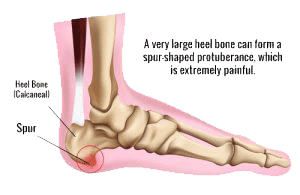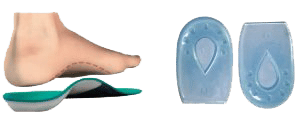A heel spur is a deposit of calcium that is located on the underside of the heel causing immense pain of the heel and painful inflammation of the plantar fascia.
Heel Spur
What is Heel Spur

What causes it?
When calcium deposits build up on the underside of the foot over many months, it causes a heel spur. Heel spurs are caused mostly by strains on ligaments and foot muscles, stretching out the plantar fascia and tearing on the heel bone membrane. Heel spurs are common in athletes who jump or run.
There are certain factors that are considered as risk factors for heel spurs:
- Excess weight
- Badly worn shoes that lack arch support
- Jogging or running on hard surfaces
- Gait abnormalities can stress the heel bone, nerves and the ligaments
- Flat feet or high arches
Symptoms
The most common complaint is a painful first step when you stand up to walk especially in the morning and being unable to walk for long distances. When you palpate the tender area you may feel a tender bony lump. Many people especially athletes describe the heel spur like a pin sticking in the bottom of the foot when walking and experience tension in their calf.
Diagnosis
Heel spurs and plantar fasciitis is usually diagnosed by your physiotherapist or your doctor based on your symptoms, history and assessment results. An X-Ray and ultrasound are sufficient in identifying a heel spur. MRI scans are also great at identifying any plantar fasciitis tears, inflammation or calcification in the foot.
Treatment
The heel pain is aggravated when the plantar fascia is stretched suddenly after sitting down for a long time, which then pulls on the heel bone. When you continue to walk, the pain decreases. But a recurrence of this pain cycle occurs after prolonged rest. If the heel pain persists for more than one week, seek the attention of a Physiotherapist or Podiatrist who may recommend some treatments such as:
- Stretching And Strengthening Exercises
- Friction Massage
- Ice Massage
- Electrotherapy
- Strapping Or Taping Stressed Tendons And Muscles
- Advice On Appropriate Shoes
- Orthotic Inserts
- NSAID’s And Corticosteroid Injections

Surgery for heel spurs
Non-surgical treatments are the most common treatments for heel spurs, but if conservative treatments fail, surgery is deemed necessary to restore the foot’s mobility. The surgical technique available includes the removal of the spur and release of the plantar fascia. Some possible complications that may arise with heel surgery include recurrent heel pain, nerve pain, numbness in the heel region, scarring and infections.
Take Home Message
- Visit Your Physiotherapist As Soon As You Can
- Get Appropriate Shoes For Each Physical Activity You Participate In
- Warm Up Before Exercises And Stretch Your Calves
What can I do to speed up my recovery?
To speed up recovery, ensure you use comfortable fitting shoes for any activity. If you are an athlete, consider taking some time off to avoid aggravating your condition. Some of the exercises that can help you have a quick recovery are included in the link below:
How long till I get better?
Heel spurs can take anywhere from 4-12 weeks to treat depending on the severity. Willingness to work with your physiotherapist is the most reliable step in reducing excessive recovery times.
Prevention
Heel spurs can be prevented by wearing fitting shoes with, supportive heel counters, good arch support, and shock-absorbent soles; choosing the right shoes for different physical activities; doing stretching exercises and warming up before each activity, and pacing your body during activities are crucial in preventing heel spurs.
Shoes with excessive wear especially on the soles and heels should be avoided. If you are overweight, reducing your weight will help prevent heel spurs from forming.
For all your Heel Spur needs, feel free to give us a call on 02 9793 8840 or Book Online

New Client Offer - 10% OFF
Are you in pain? Not sure if we can help you?
Book your initial appointment and receive 10% off any service!